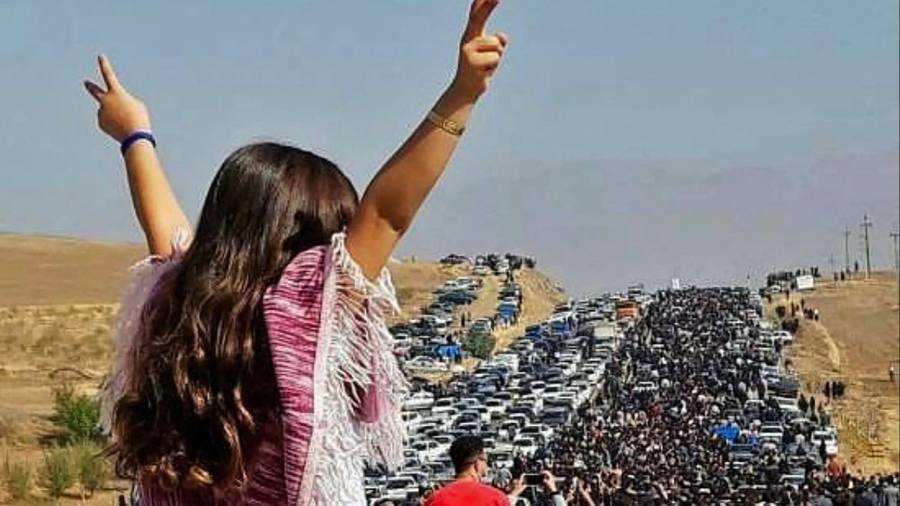When Masoud Barzani, a former president of Iraq’s Kurdistan Province, offered his condolences to the family of Mahsa Amini, an Iranian woman who died in custody after allegedly flouting the Islamic dress code, it sparked alarm in the heart of the Islamic Republic.
Amini’s death in September sparked some of Iran’s largest and longest-running anti-regime demonstrations to date. Some of the most intense protests took place in the Kurdish region amini hailed and seen widespread strikes.
Iran’s hard-line politicians fear protracted unrest will leave the country vulnerable to threats from ethnic separatists and Islamist insurgents.
“After Barzani’s call [to Amini’s family]the issue of protests [in Iran’s Kurdistan] has literally turned into a separatist movement,” an unnamed senior intelligence official told Iran’s state-run newspaper in October.
The Kurds are one of the largest stateless populations in the world, concentrated in an area spanning Turkey, Iraq, Iran and Syria. They have long complained of marginalization and have a history of rebelling against central governments in pursuit of greater autonomy or secession. The Iranian Kurds rose up against the newly formed Islamic Republic in 1979 and demanded political autonomy despite being oppressed.
In a sign of concern, the Iranian military fired ballistic missiles and armed drones at Iranian Kurdish dissident bases in northern Iraq in September in a bid to thwart what was seen as a new separatist threat. At least 13 people were killed in an attack Washington condemned as a violation of Iraq’s sovereignty.
In a statement last month expressing concerns about separatist movements, Iranian intelligence said US intelligence was fueling ethnic and religious divisions and working with exiled Kurdish groups. “Such [exiled] Groups are enemies of Iran’s beloved, brave ethnicity and separatists carrying out missions assigned to them by the US and its accomplices,” the statement said, referring to the banned Iranian Kurdistan Democratic Party.
The arrest of Kurdish politicians in Iran and the attack on Iraqi Kurdistan “helped Iranian Kurdistan calm down,” said the unnamed senior intelligence official.
The official concern speaks to concerns in Tehran over separatist tensions. Persians make up about half of Iran’s population, analysts estimate, while Turks, Kurds, Arabs and Baloch make up the rest. Kurds and Baloch are mostly Sunni Muslims — a religious minority who believe they face discrimination from Shia Muslim leaders in Iran.
In addition to the protests approx Amini’s deathThe regime was also shaken by demonstrations in the border province of Sistan-Balochistan over the alleged rape of a teenager by a police officer. According to Molavi Abdul-Hamid, the city’s Friday prayer leader, an “unprecedented” crackdown on Sunni Baluchi erupted in the provincial capital, Zahedan, in late September. At least 82 people were killed in the Bloody Friday raid, Amnesty said.
Abdul-Hamid on Friday called for an “upcoming referendum” on the constitution as a solution to solving the current crisis, rather than “locking up,” “killing” and “beating” people. According to the Iranian constitution, the country is ruled by a Shia leader.
“This nation was in the field [protesting] since about 50 days. You can’t push them back because they saw blood and their loved ones were killed,” he told Sunni Muslims at Friday prayers. “Those who drafted this constitution … were a different generation. Today there is a new generation… it’s a different world.” Abdul-Hamid has previously called for religious “freedom” and an end to “ethnic discrimination” in the country.
Brigadier General Ahmad Shafaei, a commander of the Revolutionary Guards stationed in the province, said Iranian enemies targeted Zahedan as the first city to “fall”, but the elite force thwarted their efforts.
The guards have long boasted of maintaining security in Iran despite turmoil elsewhere in the region. But the sense of insecurity was heightened when a Sunni member of the terrorist group Isis attacked a Shia holy site in the southern city of Shiraz last week, killing 13 pilgrims, according to local media.
Kurdish activists say their demands are no different from those of other protesters who have called for the regime in Tehran to be replaced with a secular, modern government.
It was Kurds who introduced the slogan “Woman, Life, Freedom” at Amini’s funeral. Since then, it has become a manifesto for protesters in Iran and has garnered worldwide attention. Demonstrators have shown solidarity with minorities, chanting slogans such as “From Kurdistan to Tehran, my life for Iran.”
Ethnic minority areas are among the poorest in the country and have some of the highest unemployment rates. Unemployment is 11.4 percent in Sistan-Balochistan and 10.2 percent in Kurdistan, compared to an average of 8.9 percent in Iran’s 31 provinces.
While many families in Sistan-Baluchistan make a living smuggling fuel into Afghanistan, tens of thousands of young men in Kurdistan work as low-paid frontier workers, known as colbars. They cross rugged mountains and carry goods on their backs, including large items like refrigerators, from the Iraqi border into Iran. Some have died at the hands of Iranian border guards, fueling anger among Kurds.
“The question of colbars keeps the demands of the Kurds alive every day,” said the Kurdish activist.
By focusing on the separatist threat, protesters say, the regime is ignoring its own failures. “Kurdistan is not into separatist movements. Officials should be asked what they have done for Kurdistan,” the activist said. “The Kurdish youth is highly educated. . . but do not see a bright future and do not have a path to senior positions in government. Such people . . . don’t want to live in exile or in the mountains.
“Iran’s Kurdistan is not strong enough to determine the future of the protests,” the activist added. “But it was the first to begin and may be the last to finish.”

